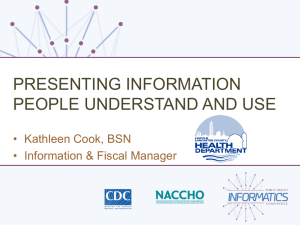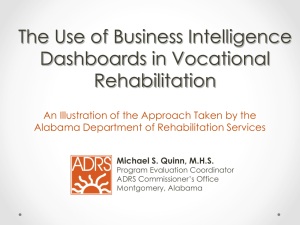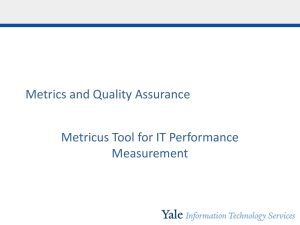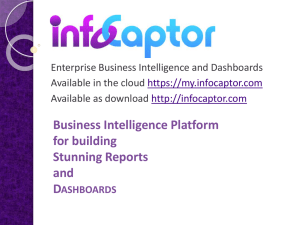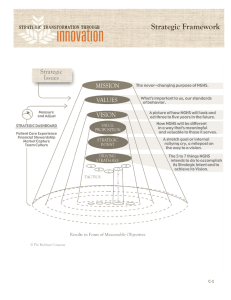Dr. Marius Pantea
advertisement
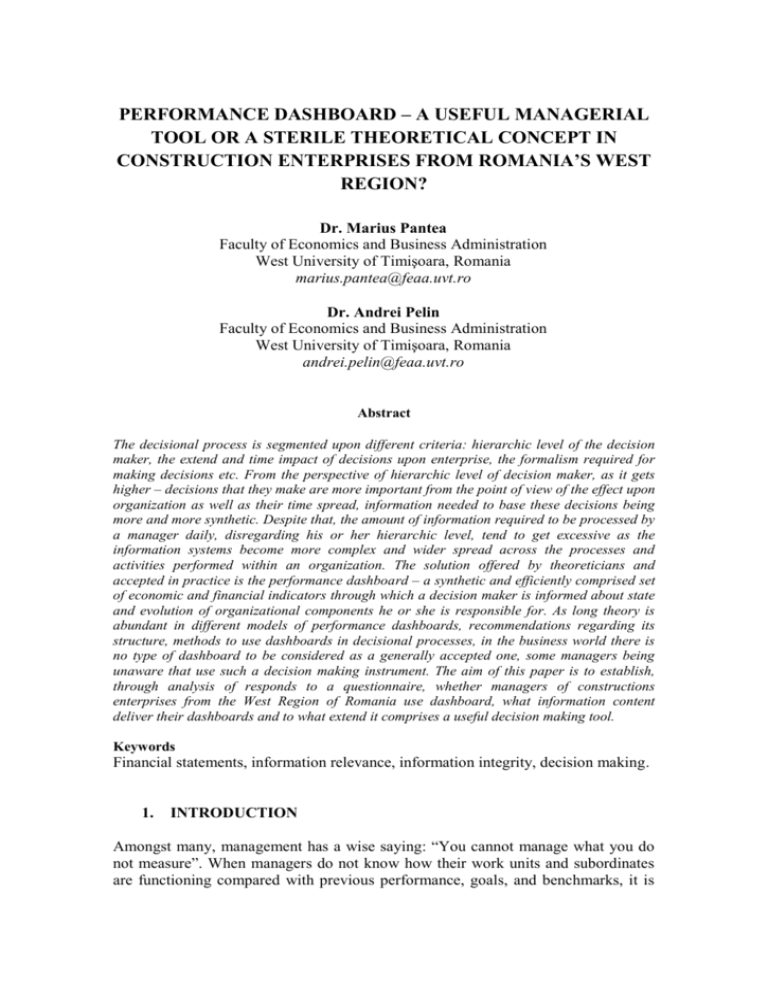
PERFORMANCE DASHBOARD – A USEFUL MANAGERIAL TOOL OR A STERILE THEORETICAL CONCEPT IN CONSTRUCTION ENTERPRISES FROM ROMANIA’S WEST REGION? Dr. Marius Pantea Faculty of Economics and Business Administration West University of Timişoara, Romania marius.pantea@feaa.uvt.ro Dr. Andrei Pelin Faculty of Economics and Business Administration West University of Timişoara, Romania andrei.pelin@feaa.uvt.ro Abstract The decisional process is segmented upon different criteria: hierarchic level of the decision maker, the extend and time impact of decisions upon enterprise, the formalism required for making decisions etc. From the perspective of hierarchic level of decision maker, as it gets higher – decisions that they make are more important from the point of view of the effect upon organization as well as their time spread, information needed to base these decisions being more and more synthetic. Despite that, the amount of information required to be processed by a manager daily, disregarding his or her hierarchic level, tend to get excessive as the information systems become more complex and wider spread across the processes and activities performed within an organization. The solution offered by theoreticians and accepted in practice is the performance dashboard – a synthetic and efficiently comprised set of economic and financial indicators through which a decision maker is informed about state and evolution of organizational components he or she is responsible for. As long theory is abundant in different models of performance dashboards, recommendations regarding its structure, methods to use dashboards in decisional processes, in the business world there is no type of dashboard to be considered as a generally accepted one, some managers being unaware that use such a decision making instrument. The aim of this paper is to establish, through analysis of responds to a questionnaire, whether managers of constructions enterprises from the West Region of Romania use dashboard, what information content deliver their dashboards and to what extend it comprises a useful decision making tool. Keywords Financial statements, information relevance, information integrity, decision making. 1. INTRODUCTION Amongst many, management has a wise saying: “You cannot manage what you do not measure”. When managers do not know how their work units and subordinates are functioning compared with previous performance, goals, and benchmarks, it is difficult to reward superior achievement or take corrective action when performance fails to meet expectations. Effective managers have always at least implicitly understood these adages and have had systems and methods for assessing how their organizations are doing. Even before computer-based systems, many executives had their staffs prepare priding books to keep a close tab on organizational performance. The critical success factor concept, which is directly related to today's key performance indicators, was designed to identify the goals and activities that need to be monitored most closely. Executive information systems, which focus on tracking key metrics important to senior management, are the most immediate precursors to today's performance dashboards. Performance dashboards integrate much of what has been learned about how computer-based systems can help in the effective management of organizations. For example, the most powerful systems are linked to company objectives. Performance dashboards also benefit from technology advances. An early problem with executive information systems was that the data required were often not readily available; considerable human effort was needed to acquire, analyze, and then enter the data into the system. Data warehouses have now made the sourcing of data much less of a problem. All said above is true merely in developed countries with tradition in market economy and management practice. Thus for developing countries, such as Romania, the use of modern management instruments is still in its incipient stages. The main way by which such techniques get used by Romanian managers is through import maid by establishment of multinational companies in our country. The other way is triggered by the growth and development of local businesses to a stage when previously used management instruments loose their efficiency, so that new ones are adopted and put to use. Usually this is done through development of customized solutions internally or externally, by outsourcing the task to a management consultant. Finally the last method of adopting new approaches to managing ever growing business structures is by adapting models of best practices from partners or even competitors. The construction industry in Romania has a lot of particularities. One of these is that the vast majority of the companies that activate in this sector are national ones. Thus the import of management techniques is a rare event. On the other hand the industry had an explosive growth for 4-5 years till 2008, when the global crisis lead to an abrupt fall in demand for constructions, so that the whole industry is experiencing a catastrophic decrease of turnover, profits and return. Taking account the described national context, there is a great need for efficient managerial instruments, such as performance dashboard, to help local companies to pass the difficult times through the economy as a whole and the construction industry in particular is going through at present. 2. LITERATURE REVIEW Despite the growing popularity of performance dashboards, both in universal and in national literature considerable confusion still exists. Common questions include: “What is a dashboard?”, “What is the difference between dashboards and scorecards?”, “What type of measures of company’s performance should a dashboard be comprised of?”. Also, there are important questions about how to build them successfully, such as: “How should I determine how many and what performance indicators to include?” “Who are the people inside the organization who need to use these performance dashboards and at which level of management?”. Right answers to these questions are difficult to find, depending on many variables, such as type and size of business, its industry of choice, its organizational structure, the formality of decision making process, the size of its management informational system etc. Many authors both on global level and national one tried to answer these questions. Thus Wane W. Eckerson in book “Performance Dashboard. Measuring, Monitoring and Managing Your Business” clears up much of the confusion about performance dashboards, addresses the most important issues, and provides answers to the most critical questions. Also the book draws up performance dashboard using three main sets of functionality: monitors critical business processes and activities using metrics of business performance that trigger alerts when potential problems arise; analyze the root cause of problems by exploring relevant and timely information from multiple perspectives and at various levels of detail; manage people and processes to improve decisions, optimize performance and steer the organization in the right direction. Ron Person in its book “Balanced Scorecards and Operational Dashboards” draws a clear line between the concepts of scorecard and performance dashboard. From the authors point of view dashboard could be either operational or tactical, scorecards operating on a strategic level. Then he describes a logical framework for developing a dashboard. Romanian literature has several main authors interested in performance dashboards. Thus the main one is undoubtedly Ion Verboncu that in his book “Tabloul de bord. Teorie, metodologie, aplicaţie” covers the main aspects of developing an efficient performance dashboard, describes the relationship between dashboard and informational system and time dimension of a manager’s work. Also he describes a personalized practical content of performance dashboard for different type of management positions in a typical enterprise. However on national level there is no statistical approach to the problem of performance dashboards used in local enterprises, let alone a construction industry centered review. Thus this paper aims to reveal the extent to which this managerial technique is used in construction enterprises from the West Region of Romania, as well as several aspects of its use in these enterprises. 3. QUESTIONNAIRE DESIGN AND STATISTICAL ANALYSIS The questionnaire developed to prospect the usage of performance dashboard in Romania’s West Region construction companies consists of 16 questions, out of which 1 question is with open answer, 7 with semi open answers and 8 with closed answers. We prepared a list of 102 construction or construction related companies from the West Region of Romania as a target group for the questionnaire. The questionnaires were administered personally or sent via e-mail. Out of these, only 63 questionnaires were filled in and returned, out of which only 51 with valid answers. Thus the questions and their answers are presented in the table bellow. Question 1 2 3 4 5 How often do you make decisions that imply calculating indicators using financial, accounting or other type of information? Absolute frequency Relative frequency What type of indicators do you use to base your decisions upon? Absolute frequency Relative frequency Do you usually use the same set of indicators or dou you adapt the set depending on decision making context? Absolute frequency Relative frequency Are you familiar with the concept of performance dashboard (PD) Absolute frequency Relative frequency The concept of PD means a managerial instrument that consists of a set of economic and financial indicators with answer a) answer b) answer c) answer d) answer e) Daily 2-3 times a week 2-3 times a month Once a month less than once a month 3 5,88% 8 15,69% 24 47,06% 12 23,53% 4 7,84% financial economic Both 21 41,18% 25 49,02% 17 33,33% A constant core of indicato rs plus variable extras 19 37,25% 13 25,49% An adapted set of indicato rs for each decision 7 13,73% Yes No 14 27,45% 37 72,55% No (go directly to quest. no. 11) Same set Yes answer a) answer b) answer c) answer d) 23 45,10% 28 54,90% What is the reason for using PD in your work? Avoid undocum ented decisions Transfer good practices from other firms Avoid overwhelming managers Other, please present it Absolute frequency Relative frequency 8 34,78% 6 26,09% 5 21,74% 4 17,39% At what level is PD used in your company? At company level At department level At project level Absolute frequency Relative frequency 17 73,91% 6 26,09% 0 0,00% Question frequently updated values upon which managers base their operational and tactical decisions. Do you use such a technique in your decision making problems? Absolute frequency Relative frequency 6 7 8 9 10 How did you develop your PD? With information from literature With information from trainings From personal experience By adapting a PD model used by other company Absolute frequency Relative frequency 3 13,04% 7 30,43% 8 34,78% 3 13,04% Other, please present it What is the main benefit of using a PD? Increased efficiency Generate d a holistic picture of business Simplify the way managers tackle the daily volume of information Absolute frequency Relative frequency 9 39,13% 3 13,04% 7 30,43% 4 17,39% To what extent efficiency of your work is determined by use of PD? PD is esesntial for my work PD is important but not essential PD is of a small importance PD is of no importance 2 16 4 1 8,70% 69,57% 17,39% 4,35% Absolute frequency Relative frequency answer e) By outsourcing the problem of PD development to a management consultant 2 8,70% answer a) Question 11 12 answer c) Yes Absolute frequency Relative frequency 17 60,71% 11 39,29% What should be the circumstances for you to implement a PD? To get a functional PD developed by theoreticians To get a PD proved functional by professionals Absolute frequency Relative frequency 4 23,53% 11 64,71% Secondary activity 11 21,57% Small 22 43,14% 2 11,76% Your company constructions as: has Main activity 14 Absolute frequency Relative frequency The size of your enterprise is: Absolute frequency Relative frequency 32 62,75% Micro 7 13,73% 15 Your position in the company is: General Manager Absolute frequency Relative frequency answer d) answer e) (please specify the reason) In the future would you be interested to use a PD? 13 16 answer b) No Other, please present it Third activity Fourth activity 6 11,76% Medium 19 37,25% 2 3,92% Large 3 5,88% Production manager Economic manager Chief accountant /financial officer Other, please specify 15 29,41% 12 23,53% 17 33,33% 6 11,76% 1 1,96% Type of your education is: Higher economic Higher technical Other types of higher education High school/ proffessi onal studies Absolute frequency Relative frequency 27 52,94% 18 35,29% 2 3,92% 4 7,84% Thus, from the first question the conclusion is that 69% of respondents use financial or accounting information at least several times/month. This means that the majority of managers are familiar to a certain extent with the content these types of information and use it in the decision making process. A cross-reference analysis reveals that the majority of the managers that use financial or accounting information have economic graduate education (87%). This situation is somewhat natural, as economists tend to be closely accustomed with using financial and accounting information in decision making. For the second questions, as one could expect, the main type of information used is financial one (41%), while 25% of managers use both types of information, an aspect that conclude the professional training of the respondents. Usually economic information requires a proper information system to provide it. Thus using strictly accounting information is easier, because of the great availability such kind of information. This finding is also related to the average small size of enterprises, which does not allow for a complex informational system to be settled in these enterprises. Almost half of the respondents use a constant set of performance measures to steer the enterprise, while 14% use context adapted sets of indicators. Each change to the basic set of dashboard instruments needs for a certain amount of skills and time. Thus only managers that have at their disposal wide enough organizational structures to contain well developed financial departments will be able to periodically or even systematically adapt the set of indicators to the decisional framework. Only 27% of managers are familiar with the concept of performance dashboard per se, although 45% admit using this technique after they are presented with its definition. This finding reveals the precarious professional training of local enterprise managers in innovative managerial techniques. For next 5 questions only the group of 23 managers that use performance dashboard in their decision making problems are subject. Thus roughly 35% of the 23 managers consider that using performance dashboards helps avoid intuitive decisions, 26% consider that the reason for using PD is to transfer good practices from other companies and 22% implement PD to avoid overcrowding managers with information. Undocumented decision is one of the major indicators of poor professional quality of managers. In a market that is passing through a profound crisis, week managerial skills lower the chances of enterprises to successfully get over the problems. The majority of respondents use PD at company level (74%) and the rest – at department level. This distribution of answers is a reason to believe that PD are developed in a way that they cover the whole company or at least its main departments, a project based approach being considered too bulky to be used in local enterprises. The main way used to develop the existent PD is by relying on personal experience of managers, closely matched by the designs inspired from trainings. This is a testimony to impossibility of adapting certain theoretical performance dashboard designs to a specific situation. Also, local managers do not trust the pure theoretical approaches to designing performance dashboards. The biggest benefit of using a PD is increased efficiency of managers and rationalizing the managers’ daily tasks. Amongst the 4 free answers to this question the main one was the quicker response to different managerial problems. The majority of respondents suggested that PD is important but not essential to their work and only 1 out of 23 respondents said that PD is of no importance to him. From the 28 respondents that currently do not use a PD, 17 answered that would be interested in developing a PD. From the 11 negative answers, the most indicate the reason for not adopting a PD solution being the need for change required to the way they currently make their decisions. The circumstances that would lead to implementation of Performance Dashboard should imply a model of PD that was proved functional by professionals in 11 (65%) cases out of 17. 4. CONCLUSIONS AND DISCUSSIONS As a result of questionnaire analysis, one could draw the conclusion that Performance Dashboard is not very widely used in management of West Region of Romania construction companies. Thus, one of the modern managerial tools has a rather low level of penetration in an industry greatly affected by global crisis. Thus the need for a more efficient decision making is not putting a great pressure on local construction enterprises, taking the account effects of abruptly fallen demand for construction works in the past two years. The form of change which is triggered by this kind of pressure in local construction companies is adaptation of prices and costs to this environment with ever shrinking demand, selling different unused or underused assets or even declaring bankruptcy. References [1] Eckerson W.W. – Performance Dashboards. Measuring, Monitoring and Managing your Business, John Wiley & Sons, New Jersey, 2006 [2] Person R. – Balanced Scorecards & Operational Dashboards, John Wiley & Sons, Indianapolis, 2009 [3] Verboncu I. – Tabloul de bord. Teorie, metodologie, aplicaţie, Editura Tehnică, Bucureşti 2001 [4] Joldeş R., Ileană I., Kadar M. – Aspecte privind tabloul de bord în activitatea managerială, 8 th International Conference, Târgu Jiu, May 24-26, 2002 [5] Jucan C. N. – Bugetele şi tablourile de bord electronice – instrumente şi tehnici moderne ale managementului de performanţă, Annales Universitatis Apulensis Series Oeconomica, 2009 [6] Gruiescu M. – Tabloul de bord – instrument al conducerii întreprinderii, Oradea University Annals, Oradea, 2006

